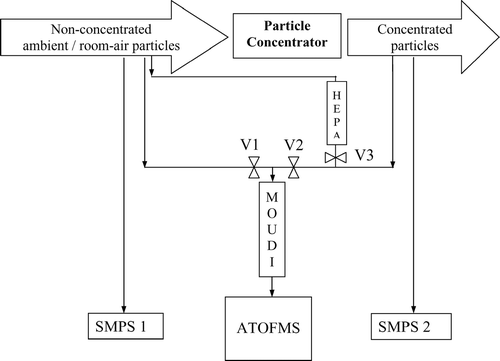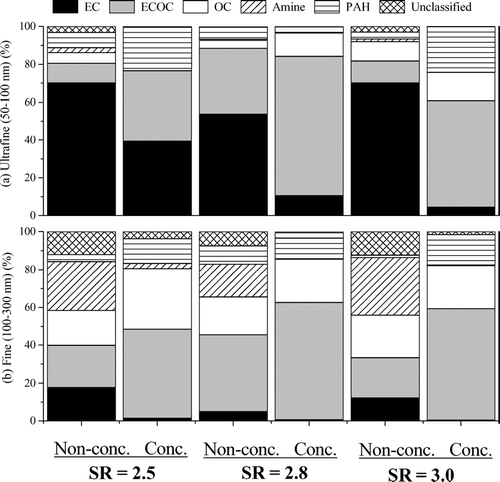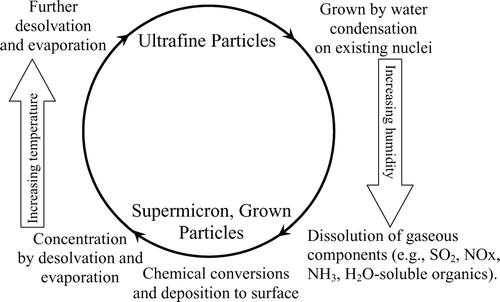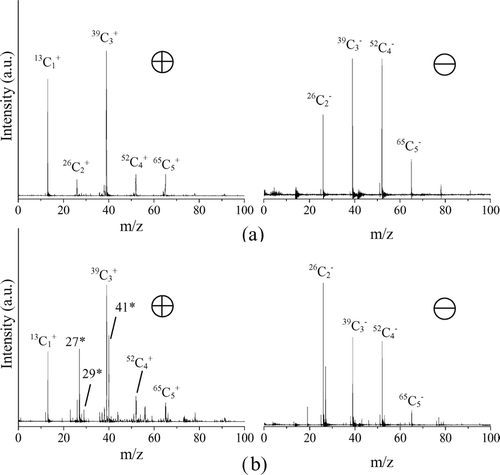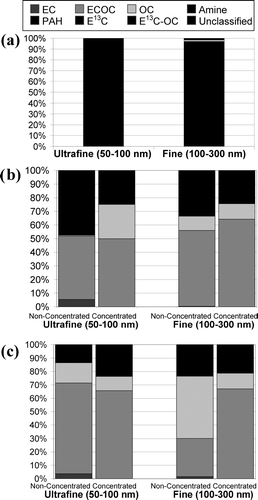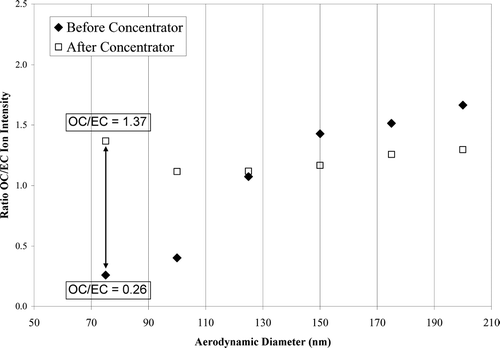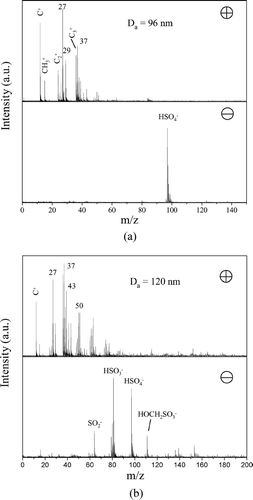Particle concentrators are commonly used for controlling exposure levels to ambient ultrafine, fine, and coarse aerosols over a broad range of concentrations. For ultrafine aerosols, these concentrators require water condensation technology to grow and enrich these smaller sized particles (D a < 100 nm). Because the chemistry of the particles is directly related to their toxicity, any changes induced by ultrafine concentrators on ambient particles need to be better characterized in order to fully understand the results obtained in health exposure studies. Using aerosol time-of-flight mass spectrometry (ATOFMS), the size-resolved chemistry was measured of concentrated ultrafine and accumulation mode (50–300 nm) particles from several particle concentrators with different designs. This is the first report detailing the size-resolved distributions of elemental carbon (EC) and organic carbon (OC) particles sampled from concentrators. Experimental measurements of the single particle mixing state of particles in concentrated versus non-concentrated ambient air show transformations of ultrafine EC particles occur as they become coated with organic carbon (OC) species during the concentration process. Based on relative ion intensities, concentrated ultrafine particles showed a 30% increase in the amount of OC on the EC particles for the same aerodynamic size. An increase in the number fraction of aromatic- and polycyclic aromatic hydrocarbon-containing particles was also observed in both the ultrafine and fine size modes. The most likely explanation for such changes is gas-to-particle partitioning of organic components (e.g., water-soluble organic compounds) from the high volume of air used in the concentrator into aqueous phase ultrafine and fine aqueous particles created during the particle enrichment process.
INTRODUCTION
Epidemiological studies suggest that the rates of morbidity and mortality increase on days with higher than normal airborne particulate concentrations (CitationDockery et al. 1993; CitationSchwartz and Dockery 1992a, Citation1992b). Adverse health effects have been reported for PM2.5 concentrations below 100 μg/m3 in epidemiological studies, much lower than those observed to cause health effects in laboratory studies (CitationPope et al. 1995). In addition to mass and number concentrations, limited epidemiological studies show that atmospheric particles of different sizes may be responsible for different levels of adverse effects (CitationWichmann et al. 2000). For example, ultrafine particles may have serious negative health effects even at low mass concentrations because of their high number concentrations, high specific surface area, and ability to penetrate into the interstitial spaces of the lungs (CitationOberdorster 2000; CitationOberdorster et al. 1992, Citation1994, Citation1995). In vivo, in vitro, and epidemiological studies have shown stronger correlations with ultrafine number concentrations and surface area than with mass concentration (CitationBrown et al. 2001; CitationGilmour et al. 2004; CitationLi et al. 2003; CitationPeters et al. 1997). Nevertheless, the adverse health effects of ultrafine particles need to be further confirmed as far fewer ultrafine health effect studies have been performed and thus less is known regarding the mechanisms of the health effects by ultrafine particles. Current regulations on particulate matter are based on particulate mass concentrations for PM10 and PM2.5 (particulate matter with aerodynamic diameters less than 10 and 2.5 μm, respectively) and do not take into account chemical composition. Despite the observation that ultrafine particles constitute the largest portion of particle number concentrations in urban areas, they are excluded from current legislation (i.e., National Ambient Air Quality Standards) because their low mass concentrations do not allow separation from fine particles by mass alone.
Besides particle size, mass, and number concentrations, the toxicity of airborne particles is also closely related to their chemical composition. For instance, for normal rats as well as rats with chronic bronchitis (CB), the lumen/wall area (LAV) ratio was found to decrease as concentrations of fine particle mass (e.g., silicon, lead, sulfate, elemental carbon (EC), and organic carbon (OC)) increased (CitationBatalha et al. 2002). However, the association for sulfate was significant only in normal rats, whereas silicon was significantly associated in both CB and normal rats; ultrafine particles coated with strong acids may cause tissue damage upon deposition (CitationChen et al. 1991; CitationLippmann et al. 1982). In addition, acids or catalytic metals on the irritant particles can be more efficiently transferred to the lungs by ultrafine particles than by an equal mass of larger particles. Investigators have also suggested that trace metals distributed widely throughout the lung on ultrafine particles could catalyze the formation of oxidants within the lung, which in turn may cause tissue damage (CitationDreher et al. 1997; CitationGhio et al. 1996; CitationWilson et al. 2002).
Since ambient concentrations of ultrafine particles are usually too low to induce observable acute effects in healthy populations, several types of particle concentrators have been developed for exposure studies of fine and ultrafine particles (CitationDemokritou et al. 2002, Citation2003; CitationKim et al. 2001a, Citation2001b; CitationSioutas et al. 1997). In general, particle concentrators typically use virtual impaction to separate the particles from the bulk of the supporting gas. However, ultrafine particles cannot be directly concentrated through virtual impaction because this requires supersonic flow and excessive pressure drops (CitationDelamora et al. 1990; CitationHering and Stolzenburg 1995) which lead to high losses of semivolatile species. Furthermore, the requirement of a high-pressure drop makes it impractical to conduct inhalation studies in animals and humans. To achieve adequate particle enrichment, the particles are grown by condensation with water prior to virtual impactor separation. Concentrated particles are then restored to their original sizes using thermal (CitationDemokritou et al. 2002, Citation2003) or diffusion dryers (CitationKim et al. 2001a, Citation2001b; CitationSioutas et al. 1997). Ambient particles experience supersaturation, condensation, and desolvation/evaporation processes inside the particle concentrator, which can cause the surface and bulk chemistry of the concentrated particles to deviate from “real-world” ambient particles. These chemical transformations may change their potential for adverse health effects when animals or humans are exposed to these particles. Therefore, it is important to understand the extent of these effects when using an ultrafine concentrator for exposure studies.
Several characterization studies on particle concentrators have been performed that primarily focused on model aerosols using bulk analysis techniques (CitationGupta et al. 2003; CitationKim et al. 2001b). These particle phase studies do not include pertinent gas phase species that can partition into ambient particles during the concentration enrichment processes. Bulk analysis techniques based on filter sampling, such as the micro-orifice-uniform deposit impactor (MOUDI) (CitationMarple et al. 1991), have been used to evaluate the mass concentration enrichment of aerosols from a versatile aerosol concentration enrichment system (VACES) (CitationKim et al. 200la, Citation2001b). The influence of the VACES concentrator on ambient aerosols was studied by collecting concentrated and non-concentrated particles using MOUDI impactors. These filter-based results showed good agreement in upstream and downstream mass concentrations of ultrafine EC (R2 = 0.94), PM2.5 nitrate (R2 = 0.66), and PM2.5 sulfate (R2 = 0.84) for non-concentrated and concentrated particles. This study did not report changes in the ultrafine or PM2.5 OC mass concentrations.
Organic compounds can be the dominant component of particles smaller than 200 nm. Fine and ultrafine aerosol particles have high surface-to-volume ratios, and thus their chemical composition can be changed by interaction with gas phase compounds such as ozone and nitrogen oxides (CitationPoschl 2002). Concentrating ultrafine particles requires particle growth at high water saturation ratios followed by size restoration through desolvation and evaporation. The importance of aqueous phase chemistry has been well documented (CitationRavishankara 1997; CitationReid and Sayer 2003) and may play a role in transforming the particle phase organic species in the concentrator after they are grown with water. Because off-line bulk analysis techniques can be affected by artifacts (CitationMcMurry 2000; CitationSipin et al. 2003) measurement and comparison of the chemical composition of the organic species in individual concentrated and non-concentrated particles as described herein may provide useful information on the chemical and physical processes occurring inside a particle concentrator.
In addition to probing chemical changes, characterization studies have also been performed on the effect of the VACES on the physical properties of aerosol particles. A study on the VACES reported no significant change in the morphology of the particles (CitationKim et al. 2001b), however the fractal analysis was performed in an evacuated environment that could lead to evaporation of species which could cause changes in the particle morphology (CitationMaynard et al. 2000). In contrast, agglomerated soot particles, which often represent a significant fraction of ultrafine particles in urban areas (CitationHughes et al. 1998; CitationCass et al. 2000), have been observed to collapse in size due to capillary forces when exposed to high humidity conditions (CitationWeingartner et al. 1995). Subsequent removal of water from the particles grown via condensation may not restore particles back to their original morphologies.
In this article, results are reported from a chemical characterization study of individual concentrated ambient ultrafine (50–100 nm) and fine (100–300 nm) particles from several ultrafine particle concentrators. An aerosol time-of-flight mass spectrometer (ATOFMS) was used to probe the aerodynamic size and chemical composition of individual fine and ultrafine particles, focusing on the organic and elemental carbon fractions, during the course of the ultrafine concentrator experiments. The compositions of individual concentrated and non-concentrated particles from ambient air are directly compared to determine whether the concentrator affects the resulting chemical composition based on single particle signatures.
EXPERIMENTAL
Experimental Setup
The experimental set-up for the concentrator experiments is shown in . For direct sampling ambient particles, valve V1 was opened while valves V2 and V3 were closed. For sampling concentrated particles, valve V1 was closed while valves V2 and V3 were opened. To avoid overwhelming the ATOFMS with high particle number concentrations, the concentrated particles were diluted using particle-free air through a HEPA filter. The non-concentrated or concentrated ambient flow was then pulled through a MOUDI (MSP Corporation, Model 100) with a flow rate of ∼26 L/min to remove most of the particles larger than 250 nm in aerodynamic diameter. The last two impactor stages with cut-point diameters of 0.1 μm and 0.056 μm were removed from the MOUDI and the ATOFMS sampled the remaining smaller particles from the bottom stage (cut-point diameter 0.18 μm) of the MOUDI. Two identical scanning mobility particle sizers (SMPS), each consisting of a differential mobility analyzer (Model 3081, TSI Incorporated) and condensation particle counter (Model 3010, TSI Incorporated), concurrently monitored the number concentration of the non-concentrated and concentrated ambient particles over the particle size range studied.
Harvard Ultrafine Concentrated Ambient Particle System (HUCAPS)
Details on the HUCAPS have been described previously (CitationDemokritou et al. 2002) and are briefly presented here. Ambient air was drawn at an input flow rate of 5000 L/min and an output flow rate of 65 L/min. Particles less than 200 nm in aerodynamic diameter were grown by condensation to supermicron sizes using deionized water. The saturation ratio (SR) for water, the ratio of the water vapor pressure to the water saturation vapor pressure at a given temperature (CitationHinds 1999), was precisely controlled. The water vapor is saturated when a saturation ratio is equal to unity, and the water vapor is supersaturated when the saturation ratio is greater than unity. The saturation ratio was typically maintained at SR = 3.0 under normal operating conditions. The grown particles were concentrated through a series of two virtual impactors with a combined number concentration enrichment factor (CEF) of 30–50. The concentrated particles were thermally size-restored by injecting hot, dry particle-free air (15 L/min) into the concentrated aerosol flow (50 L/min) to remove excess water from the grown particles. A prototype of this high volume particle concentrator thermally dried the concentrated aerosol flow through a series of heated parallel tubes instead of injecting a hot stream of particle-free air. The input and output flows of the prototype were 2000 L/min and 20 L/min, respectively.
Versatile Aerosol Concentration Enrichment System (VACES)
Details on the VACES have been described previously (CitationKim et al. 2001b) and will only be briefly presented here. Ambient air was drawn into the concentrator at a flow rate of 330 L/min. The total input air flow was divided into three sampling lines and drawn over a heated deionized water pool with water vapor temperature of 30–35°C. Particles and vapor from each 110 L/min flow were cooled to ∼20°C by drawing the air through a stainless steel condenser tube refrigerated in a recirculation antifreeze bath at −9°C. The particles grown by water condensation were then concentrated using a virtual impactor located at the end of each stainless steel tube each with a minor flow of 5 L/min. The concentrated flow was diluted with another 5 L/min of particle-free room air. After the particle sizes were reduced using diffusion dryers to remove the excess water, the three concentrated particle flows were recombined with total output flow of 30 L/min.
Aerosol Time-of-Flight Mass Spectrometer (ATOFMS) and Data Analysis
The ultrafine-ATOFMS (UF-ATOFMS) used in this work was developed specifically for characterizing individual fine and ultrafine particles. Details of the UF-ATOFMS system have been reported by CitationSu et al. (2004). Particles were sampled into the ATOFMS through an aerodynamic lens system which focuses the particles into a tight, narrow beam through a series of expansions and contractions. The aerosol undergoes a supersonic expansion after exiting the aerodynamic lens which accelerates the particles to specific terminal velocities that are correlated with their aerodynamic diameters (i.e., smaller particles travel at higher velocity). Individual particles are aerodynamically sized in a light scattering region by measuring their transit time between two scattering lasers followed by desorption and ionization in the source region of the mass spectrometer. Positive and negative ions generated from each hit particle were detected using a bipolar time-of-flight mass spectrometer, providing complete chemical composition information at the single particle level.
Mass spectra are calibrated using software developed in the Prather group (CitationDienes 2002). A MATLAB neural network algorithm based on a fast adaptive resonance theory (ART-2a) (CitationSong et al. 1999) uses the dot product of the mass spectra to cluster the mass spectral signatures based on the degree of similarity defined as the vigilance factor. The vigilance factor for this study was 0.7 with a learning rate of 0.05 at 20 iterations. Similar clusters were grouped by manual inspection to further simplify the number of particle types. Because the ATOFMS exhibits size-dependent particle detection efficiencies (CitationSu et al. 2004), the ATOFMS number counts are scaled using SMPS number concentrations before determining the fraction of each particle type.
Concentrator Apparatus and Site Descriptions
Four concentrator systems were characterized in separate locations. First, a prototype HUCAPS (HUCAPS I) was characterized on the third floor of the medical center annex at the University of Rochester in Rochester, New York. A second generation HUCAPS (HUCAPS II) was operated in Chapel Hill, NC. The third generation HUCAPS (HUCAPS III) was used in Boston, Massachusetts. Finally, a VACES system was operated on the first floor of the Nelson Institute Building at New York University in Tuxedo Park, New York, a rural forested area approximately 50 miles northeast of New York City.
The HUCAPS I sampled ambient air for an eight-hour period for two consecutive days during which the ATOFMS sampled only concentrated particles. The concentrated aerosol flow was diluted to a 1:14 ratio using particle-free medical grade air. After this concentrator experiment, the ATOFMS was used to sample ambient particles directly (non-concentrated) for eight days. Detailed results from this eight day ambient study will be presented in a separate paper (CitationSu et al. 2005). The sampling site for both the concentrator and ambient experiments was adjacent to a road with moderate traffic levels where vehicle emissions are known to be the major contributor to ultrafine and fine particles. Due to inefficient particle drying in this prototype concentrator (where parallel heated tubes were used as opposed to the injection of hot dry air in the advanced model), the concentrated aerosol flow from the output of the prototype concentrator had a relative humidity of ∼100%, altering the profile of the number concentration distribution of concentrated particles.
The HUCAPS II injected hot air into the thermal dryer region after the enrichment process and was maintained at a SR = 3.0. The sampling site was located at the United States Environmental Protection Agency Human Exposure Facility on the University of North Carolina, Chapel Hill campus. Ultrafine particles in this area were mainly emitted by vehicle traffic. ATOFMS sampling alternated between non-concentrated and concentrated particles at 75-minute intervals. A 1:48 dilution was used for concentrated particles using particle-free ambient air.
The HUCAPS III differs from the HUCAPS II only by using a more sophisticated system for feedback control. Ambient air was sampled on the fourth floor of a parking lot adjacent to an office building structure. Major sources of fine and ultrafine particles at this site were largely influenced by vehicle emissions and the cooking exhaust from several nearby vent ducts from a movie theatre and a restaurant located in the same building structure. ATOFMS sampling alternated between non-concentrated and concentrated particles at 15-minute intervals. A 1:17 dilution was used for concentrated particles using particle-free ambient air. Detailed operational parameters for the three HUCAPS systems are shown in .
TABLE 1 Operating parameters for HUCAPS and its prototype
The fourth concentrator tested was a VACES in Tuxedo Park. Biogenic, biomass, and vehicle emissions were the likely major contributors to the fine particle composition at this site. Ambient air was drawn through a PM2 cyclone at 330 L/min. The concentrated particle flow was diluted using particle-free ambient air with a ratio of 1:3 prior to ATOFMS sampling. ATOFMS sampling alternated between the concentrated and non-concentrated particles at 75-minute intervals.
In the Boston study, the effect of the concentrator on chemical transformations in a control experiment was investigated by producing elemental 13C particles using a Palas spark discharge generator (Palas GFG 1000, Palas GmbH, Karlsruhe, Germany) with an Ar flow of 4 L/min and a discharge frequency 180 Hz. The 13C isotope is present in the atmosphere in low natural relative abundance (1.07%) making it ideally suited for monitoring changes in particle composition. The 4 L/min Palas generated 13C flow was diluted using particle-free room air flow (1:1250 dilution ratio) to provide a total input flow of 5000 L/min to the concentrator. ATOFMS sampling alternated between non-concentrated and concentrated particles at 30-minute intervals. The experiment was also repeated using particle-free ambient air. As part of the Boston study, the effect of varying the saturation ratio on the chemical composition of individual ambient particles was further investigated. Previous studies on the development of the HUCAPS have reported an optimal saturation ratio of 3.0 (CitationGupta et al. 2003). At saturation ratios less than 3.0, there is a chance the concentrator does not grow (or activate) and thus concentrate all particle compositions equally (i.e., hydrophobic). The HUCAPS III was operated at SR = 2.5, 2.8, and 3.0 by adjusting the temperatures of the condenser and saturator.
RESULTS AND DISCUSSION
Particle Size Restoration and Number Concentration Enrichment
shows the number distributions versus particle size for non-concentrated and concentrated ambient particles at all four sampling sites (summarized in ). The HUCAPS I shifted the number distribution of concentrated particles to larger sizes (). Based on the total concentrations between non-concentrated and concentrated particles, the enrichment process only resulted in a number concentration enrichment factor (CEF) of 5.6. The CEF is defined as the ratio between the total SMPS number concentration of the concentrated particles and the total number concentration of non-concentrated particles for the size range investigated. The observed CEF is significantly lower than the theoretical value of 100 based on the input flow (2000 L/min) to the output flow (20 L/min) ratio. Under such high saturation and inefficient drying conditions, particles may have coagulated, causing the size shift and decreased number concentrations due to inefficient drying. Additional particle losses may have occurred when the wet concentrated flow was transported to the outlet of the concentrator.
FIG. 2 Particle number distribution versus particle size for (a) HUCAPS I, (b) HUCAPS III, (c) HUCAPS II, and (d) VACES.
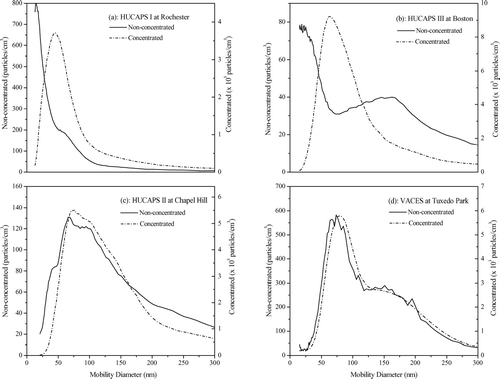
TABLE 2 SMPS statistics for non-concentrated (NC) and concentrated (C) particles and concentration enrichment factors
The theoretical concentration enrichment factors for the HUCAPS II and III are ∼77 and ∼86, respectively, based on the input and output flow rates. While this high value was somewhat difficult to achieve in the initial concentrator, improvements implemented on HUCAPS II and III have achieved CEF values of 40 and 65, respectively. In some cases, results from HUCAPS show incomplete size restoration ( and ). The particle drying conditions during the concentrator experiments in Rochester and Boston were not fully optimized as the temperatures used in these studies for drying the particles back to their original sizes were too low. and likely represent the extreme cases for not achieving size restoration. Other SMPS results using indoor air have shown proper size restoration for the HUCAPS III (CitationDemokritou et al. 2002; CitationGupta et al. 2003). Furthermore, during the HUCAPS II characterization study, proper size restoration was achieved as illustrated in with a number concentration enrichment factor of 40, in good agreement with the concentrator experiments performed using indoor air (CitationGupta et al. 2003). For the VACES, a proper size restoration was reached throughout the size range investigated with a CEF of 11 ().
shows the number concentration enrichment factors across the size range investigated at Chapel Hill (HUCAPS II) and Tuxedo Park (VACES). For the HUCAPS II, the CEF is relatively uniform from 75 to 150 nm and falls sharply for smaller sizes which could be due to the fact the smaller particles were not activated and thus not enriched at the saturation ratios used. For the VACES, the operating flow rates and saturation ratios (< 2.0) are lower than the HUCAPS systems. Based on the input and output flow rates, this VACES setup has a theoretical CEF of 11 which is consistent with the observed CEF value that remained relatively constant for particles above 100 nm (). The CEF drops nearly linearly for sizes smaller than 100 nm, likely due to inefficient growth of ultrafine particles because this system was operated with a lower saturation ratio. Diffusion losses within the sampling lines may also play a role in the decreased CEF values for particles below 100 nm.
Effect of Condensational Growth on Chemical Composition
Particles were categorized into five major classes: EC, EC coated with organic carbon (ECOC), OC, polycyclic aromatic hydrocarbons (PAH), and amines. Representative positive and negative spectra for these five classes are presented in . The most common particle type observed by the ATOFMS in the ultrafine non-concentrated ambient particles was the EC type (). The positive ion mass spectrum of an EC particle exhibited intense peaks at mass/charge ratios (m/z) of 12, 24, and 36 corresponding to 12C1 +, 24C2 +, and 36C3 +. For the ECOC type particle (), the typical EC peaks were present with the notable addition of hydrocarbon peaks at higher m/z values (e.g., 15CH3 +, 27C2H3 +, 29C2H5 +, and 43C3H7 +) which are highlighted by asterisks (*). A typical OC type particle () shows dominant peaks at m/z = 15, 27, 29, 43, 50, and 51. It is important to note the particle types exhibit a spectral continuum, shifting from showing mostly EC (peaks at m/z 12, 24, 36, 48, etc.) to ECOC (a blend of EC and OC ion peaks) to OC dominated spectra (peaks at m/z 15, 27, 29, 43, 50, 51) as size increases. The labels used to classify these carbonaceous particles are based on the relative abundances of the dominant peaks in the spectra. Concentrated particles containing PAH species show high mass ion peaks above m/z = 170 as shown in . Interestingly, the negative ion spectra of the PAH particles showed peaks at m/z −46 (NO2 −) and −62 (NO3 −) as well as sulfate. The relatively intense peak at m/z −46 can form by fragmentation of −62 (NO3 −), and also serves as an indicator of nitro-PAH species (CitationBezabeh et al. 1997, Citation1999). This observation is consistent with nitro-PAH species having lower volatility and higher solubility in the particle phase. Additional markers for aromatic compounds appear as fragment ions at m/z = 77 (phenyl cation, [C6H5]+) and m/z = 91 (tropylium ion, [C7H7]+), as well as molecular ions at m/z = 202 (pyrene ion or fluoranthene ion, [C16H10]+), and m/z = 228 (chrysene ion, [C18H12]+). Amines were identified by peaks at m/z = 58 or 59 ([C3H8N]+ or [C3H9N]+) and m/z = 86 ([C5H12N]+) (CitationAngelino et al. 2001) as shown in .
FIG. 4 Single particle ATOFMS mass spectra for (a) EC, (b) ECOC, (c) OC, (d) PAH, and (e) amine type particles.
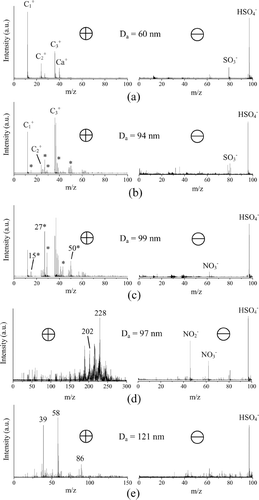
The particles sampled from all four concentrators showed changes in their mass spectra, indicating altered chemistry of the particles. shows the relative number fractions of the five major particle types detected for both non-concentrated and concentrated particles. In general, concentration of the particles resulted in a decrease in the fraction of EC particle signatures, with a corresponding increase in the ultrafine ECOC and OC fractions. This change in the fractions of the major particle types reflects how nominally pure ultrafine EC particles convert to organic carbon and OC/EC ion signals. For the HUCAPS experiments ( and ), the most obvious change for ultrafine particles (50–100 nm) is the depletion of the relative percentage of EC particles from ∼70% in the non-concentrated particles to < 5% in the concentrated particles, and the corresponding increase of ECOC particles from ∼10–20% in non-concentrated particles to 35–55% in concentrated particles. The increase of ECOC in concentrated fine particles (100–300 nm) observed for HUCAPS III () and HUCAPS II () is consistent with the size shift observed by the SMPS and can be explained by organic coatings on particles that were originally in the ultrafine range (< 100 nm). A change was not observed in the fraction of fine concentrated OC particles in most cases because most of the fine particles were already classified as OC. As particles are subjected to the concentration process, they become more highly coated with organic carbon (most likely water soluble organic species), and the presence of aromatic and PAHs are enriched particularly in the ultrafine region (50–100 nm) for all three urban sites using the HUCAPS (, , ). In contrast, the ion signals from amines are reduced downstream of the HUCAPS, possibly due to volatilization losses during the thermal drying process. It is interesting that the semivolatile amines are reduced downstream of the concentrator, whereas the aromatic and PAH species show an increase. There are several possible explanations for this observation: (1) the aromatic compounds may have become oxidized or nitrated in the aqueous phase, thus lowering their vapor pressures, or (2) the PAH species became associated with other insoluble compounds in the particles and thus were not easily removed upon heating (CitationHerckes et al. 2002), and/or (3) the PAH dissolved into an organic/aqueous phase whereas the amines remained on the surface of the particles and thus were more easily removed. Understanding the factors controlling gas/particle partitioning of organic species and potential aqueous phase processing is an area that merits further exploration, because increases of these species in the particle phase has significant toxicological implications (CitationBolton et al. 2000).
FIG. 5 Number fraction of EC, ECOC, OC, amine, and PAH particles for (a) HUCAPS I, (b) HUCAPS III, (c) HUCAPS II, and (d) VACES.
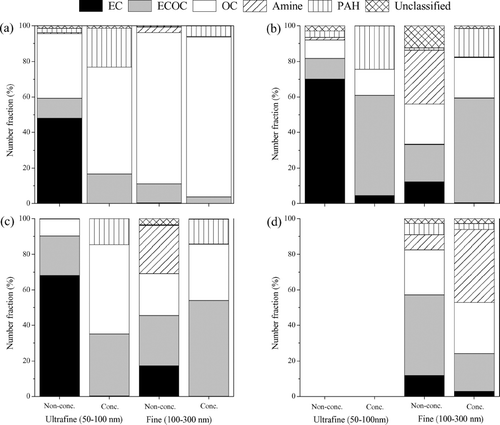
Very few ultrafine particles were detected by the ATOFMS from the VACES in Tuxedo Park, most likely as a result of diffusional losses in the long sampling lines required at this site. The sampling line was several times longer than those used at the other three sites. These losses were confirmed by the SMPS ultrafine concentrations which were reasonably high near the exit of the concentrator. Decreases in both the EC and ECOC particles and an increase in amine type particles were observed in the fine particles (100–300 nm) downstream of the VACES. Semivolatile and/or water soluble amines originating from combustion and other sources partitioned onto a large fraction of EC and ECOC particles, reducing the EC signature in the concentrated particles. No significant change in the fraction of fine PAH particles was observed. Compared to the other three urban sites where the HUCAPS I-III characterization studies were performed, the composition and concentrations of particulate matter and gas phase components in Tuxedo Park (a rural forested area) were very different. Also, the employment of diffusion dryers for removing water from concentrated particles may lower the loss of semivolatile organic compounds (SVOC). Further studies are necessary to characterize the composition of VACES concentrated ultrafine particles.
Laboratory experiments have shown that the relative humidity difference between the inlet and outlet of concentrators does not significantly affect the ATOFMS detection of EC, ECOC, OC, and PAH particles (CitationSpencer et al. 2005). In addition, several characterization studies of particle concentrators have demonstrated that the use of virtual impactors does not have a significant effect on the potential toxicity of model particles in the fine (0.1–2.5 μm) size range (CitationSavage et al. 2003), and application of this concentrator for human exposure studies using ambient particles has been reported (CitationGhio et al. 2000). In addition, a chemical characterization study on a coarse (2.5–10.0 μm) concentrator (CitationDemokritou et al. 2002) demonstrated no significant changes occur in the chemical composition of individual coarse ambient particles (CitationMoffet et al. 2004). However, neither of these (fine or coarse) particle concentrators utilize condensation to grow the particles or require subsequent drying of enriched particles. Therefore, changes in the particle chemical composition observed in the particle concentrators investigated in this study are believed to be mainly due to dissolution of gaseous organic compounds present in the gas phase upstream of the concentrator during the particle growth process.
Effects of Saturation Ratio on Concentration Enrichment Factor and Chemical Composition
The HUCAPS III increased the total particle number concentration while altering the chemical composition of the concentrated ultrafine particles as a function of saturation ratio (SR = 2.5, 2.8, and 3.0). As shown in , the total particle number concentration was greatly enhanced for all concentrator saturation ratios while shifting the size profile to larger particle sizes. In particular, the total particle number concentration was increased by 64 times (CEF = 64) and the median particle size was increased from 40 nm to 75 nm at SR = 3.0. The results at other saturation ratios have been summarized in . Saturation ratios less than 3.0 were found to be less efficient in growing particles because the activation for particle growth is governed by the hygroscopic characteristics of the particles, resulting in lower CEFs. This result is consistent with a previous study which showed that the optimum operating conditions for the HUCAPS III was determined to be SR = 3.0 for room air and lab generated aerosols with different hygroscopic properties (CitationGupta et al. 2003).
FIG. 6 Average SMPS number distribution versus particle size for non-concentrated and concentrated particles at SR = 2.5, 2.8, and 3.0.
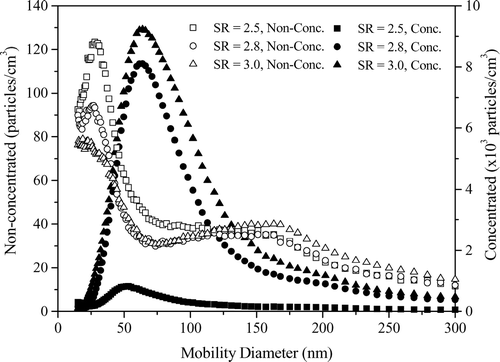
TABLE 3 Concentration enrichment factors and SMPS statistics for non-concentrated (NC) and concentrated (C) particles under different saturation ratio (SR) in Boston
Results from single particle analysis clearly show that composition changes occur in the concentrators at all saturation ratios. shows the number fraction of ultrafine (50–100 nm) and fine (100–300 nm) EC, ECOC, OC, amine, and PAH particles under non-concentrated and concentrated conditions at different saturation ratios. The fraction of ultrafine EC particles sharply decreases after the particles pass through the concentrator for all three saturation ratios. The amount of chemical change increases with an increasing saturation ratio. As the saturation ratio increases, the number of pure EC particles decreases, while the fractions of ECOC and PAH particle types increase. Again, this suggests that the concentrator is coating the EC particles with OC and PAH species as discussed.
Processes of Particle Growth and Size Restoration in the Concentrator
shows the processes of particle growth and desolvation/evaporation in the HUCAPS and VACES systems. The interactions between the gas, aqueous, and particle phases have been found to be important in acid rain, fog formation and dissipation (CitationMunger et al. 1986), and in the growth of aerosol particles. For example, nucleation processes have been studied by simultaneously measuring ultrafine particles and gaseous H2SO4 (CitationEisele and McMurry 1997; CitationWeber et al. 1996, Citation1997, Citation1998) and it has been suggested that organic species contribute to the growth of ultrafine particles once nucleation has occurred (CitationMarti et al. 1997; CitationWeber et al. 1997).
During the concentration enrichment processes, ambient air carrying gas phase compounds and particles is directed into a chamber where steam is injected to grow the particles to sizes above ∼1.0 μm by supersaturation and condensation (CitationDemokritou et al. 2002). As the water condenses, the particle components become increasingly dilute, and the liquid droplets will begin to take up gaseous compounds, such as water-soluble organic carbon (WSOC) species and SO2, as the aerosol re-establishes gas/particle equilibrium concentrations. Subsequent rapid aqueous phase reactions, such as the oxidation of sulfur and organic species, may occur within the individual aqueous droplets. After aqueous phase oxidation reactions, the more highly oxidized species will have lower vapor pressures and thus be more difficult to remove when temperatures are increased for size restoration. Such concentration enrichment processes may account for the increased fraction of ECOC and OC particles observed in these concentrator experiments.
The conversion and coating of OC on ambient EC particles result in the increased number fractions of concentrated ECOC and OC particles. Studies of fog processing have shown that species typically associated with the gas phase may occur more in the particle phase (CitationBlando and Turpin 2000; CitationFuzzi et al. 2002). Although many gas phase organics released into the atmosphere have high vapor pressures and low water solubility initially, they become more soluble upon atmospheric oxidization as well as show increased solubility in the combined aqueous/organic phase of fog droplets (CitationAtkinson 2000; CitationHerckes et al. 2002). The organic compounds can be absorbed into suspended water droplets or liquid layers on the surface of a particle where they can undergo aqueous phase chemical transformations with other compounds present in the particle. It is possible some organic aqueous phase oxidation reactions could lead to reactive oxygen species and this could change their potential toxicity (CitationHasson and Paulson 2003). Such aqueous transformations have been suggested to contribute to secondary organic aerosol (SOA) formation during fog and cloud processing (CitationBlando and Turpin 2000). One other possibility is that soluble components buried in the core of the particle could be redistributed throughout the particle, thus altering the chemical composition of the particle surface which may have toxicological impacts. Subsequent evaporation of water from these droplets or liquid layers could leave the low volatility products created by aqueous phase reactions in the particle phase, enriching their concentrations.
In this work, the increased number fraction of PAH-containing particles exiting the concentrator suggests that gaseous PAHs upstream of the concentrator partitioned into particles during the concentration process. The partitioning of gas phase semivolatile PAHs to the particle phase depends on the temperature (CitationSonnefeld et al. 1983) and thus the decrease in temperature in the saturator could also enhance gas-to-particle partitioning. PAHs have been shown to have an enhanced solubility in mixed aqueous/organic fogwater solutions (CitationCapel et al. 1991). Smaller molecular weight PAH species (2–3 ring), including oxy-PAHs, have been measured in the dissolved phase of fogwater, while larger PAH species which have lower solubility were detected in association with insoluble materials (CitationHerckes et al. 2002). The increased presence of PAH species could have important health effects as oxidized PAH species such as quinones have been shown to exhibit higher toxicity (CitationBolton et al. 2000; CitationFinlayson-Pitts and Pitts 2000; CitationXia et al. 2004).
Concentrator Induced OC Coating Characterized Using Elemental 13C Particles
The extent of the coating/partitioning processes inside the particle concentrator was further investigated using 13C elemental carbon (E13C) particles generated by a Palas spark discharge generator. When first produced, E13C particles produce a distinct mass spectral signature as shown in with characteristic peaks corresponding to 13C1 +, 26C2 +, 39C3 + in the positive mass spectrum and peaks corresponding to 26C2 −, 39C3 −, 52C4 − in the negative ion mass spectrum. A representative spectrum of an OC coated E13C particle (E13C-OC) is shown in where the organic ions are highlighted by asterisks. The number distributions as a function of particle size are shown in for particle-free room air diluted and ambient air diluted E13C particles under both concentrated and non-concentrated conditions. Note that the concentrated particles are not completely restored to their original sizes.
FIG. 10 Number concentration distribution verus particle size for particle-free room air with 13C-containing particles and ambient air with 13C-containing particles.
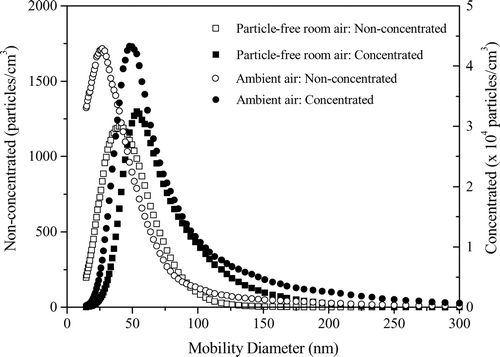
The SMPS measurement results are further summarized in . The CEF values for E13C particles () are lower than those obtained using the same concentrator for ambient air (). One possible explanation is that the surfaces of EC particles in the atmosphere are more aged/oxidized and thus not as hydrophobic as the E13C particles produced by the Palas generator. As a result of their more hydrophilic nature, ambient EC particles can be grown and concentrated more readily than the Palas generated E13C particles (CitationZuberi et al. 2005).
TABLE 4 SMPS statistics for non-concentrated (NC) and concentrated (C) particles and concentration enrichment factors for the HUCAPS 13C experiments
Both the dilution air and processes within the HUCAPS III altered the fraction of pure E13C resulting in more OC/EC particles. When the particles were directly sampled from the Palas generator (diluted 17 times with particle-free room air), E13C was the dominant (82%) ultrafine particle type observed (). However, after the 4 L/min flow of E13C particles was diluted with a higher volume of 4995 L/min particle-free room air, even the non-concentrated particles showed a decrease in the pure E13C signature, representing only about 30% of the ultrafine particle concentration, with a corresponding increase in the fraction of E13C/OC particles to ∼46%. After passing through the concentrator, the remaining 30% of the ultrafine E13C particles were completely depleted. In an E13C experiment using particle free ambient air as the dilution gas, non-concentrated particles with an E13C signature represented only 2% of the ultrafine particles as opposed to ∼30% in the E13C experiment using particle-free room air. This difference is very likely due to the higher concentration of semivolatile gas phase organic species in ambient air over room air. Ideally, to avoid adding organic species to the particles upon introduction of the dilution air, one could use denuders to remove the gas phase species. However, with these high volumes of air, denuding the air flow would be quite challenging.
Quantification of OC on EC Particle Cores via Tandem DMA Measurements
Based on the shift in the fraction of particle types, it is clear the single particle mass spectral signatures for carbonaceous components change after passing through the concentrator, in particular for the smaller (ultrafine) particles ( and ). Specifically, a shift occurs from the mass spectra being dominated by EC (m/z 12, 24, 36) to OC ion peaks (m/z 27, 29, 37, 39, 41, 43, 50, and 51). However, this level of analysis does not provide a quantitative measure of the amount of the change occurring that is useful for toxicological studies (CitationZhao et al. 2005). In order to assess the amount of OC added to the EC particles, the ratio of the sums of the OC ion peak intensities divided by the EC ion peak intensities for each particle were calculated. shows the OC/EC ion intensity ratios as a function of size for upstream versus downstream particles sampled from the concentrator. The largest difference for upstream versus downstream OC/EC ratios is observed for the smallest particles in the 50–100 nm size range (indicated by arrow). The amount of OC relative to EC increases as a function of size for unconcentrated ambient aerosols, whereas for concentrated aerosols the OC/EC ratio remains relatively constant. As described, the concentrators grow particle sizes through water steam introduction and condensation processes, and thus a new equilibrium for water-soluble OC species between the gas and particle phase must be established under these conditions. In order to relate the measured OC/EC ion intensity ratios to the relative mass fractions of EC and OC in individual particles, tandem DMA laboratory studies were performed in which EC particles generated with a Palas spark discharge generator were size selected based on electrical mobility using a DMA and sent through a flow tube where they were coated with organic carbon species (CitationSpencer et al. 2005). These OC-coated EC particles were then size selected using a second DMA before analysis with the ATOFMS. Using the electrical mobility size along with aerodynamic size data measured with the SMPS and ATOFMS, respectively, the mass percentage values of OC coated on EC were calculated and plotted against the measured OC/EC ion intensity ratios. A linear relationship was obtained with an R2 of 0.989. Using the linear fit obtained from these experiments, the measured downstream OC/EC ratio for particles in the 50–100 nm size range corresponds to a 30% OC mass percentage versus 5% OC on EC for the upstream particles for the same (ultrafine) size range. This suggests that ultrafine particles downstream of the concentrator have picked up a significant fraction of OC in the concentration enrichment process. This most likely occurs when the particles are grown with water in a high relative humidity region (saturation ratio > 1). As the organic components in the particle become more dilute, gas/particle partitioning of water soluble organic species shifts from the gas to particle phase to re-establish equilibrium. Rapid aqueous phase oxidation reactions can then occur, and when the particles are restored to their original size the lower volatility (reacted) organics remain associated with the particles. In general, it is assumed that the growth process is reversible and that the species added to the particle will be removed when particle size is restored (CitationKhlystov et al. 2005). However, this assumption is only valid if the added species do not react to form lower volatility products.
A recent study by Wexler et al. studied changes in the VACES system using another single particle mass spectrometer (CitationZhao et al. 2005). The RSMS-3 instrument uses a different laser operating at 193 nm (as opposed to 266 nm, herein) for the laser desorption/ionization process. The shorter wavelength results in extensive fragmentation of OC species, making it difficult to differentiate EC from OC. No attempt was made to distinguish between OC and EC fractions in their study.
Aqueous-Phase Sulfur Chemistry
The formation of hydroxymethanesulfonate (HMS) was shown to be enhanced at the Rochester, New York, site during the concentration process indicating that aqueous phase chemistry was occurring in the HUCAPS I. The positive ion mass spectra for both non-concentrated () and concentrated () particles featured the expected OC type fragmentation envelopes centered around the peaks at 12C+, 15CH3 +, 27C2H3 +, 37C3H+, and 43C3H7 +. However, the negative ion mass spectra showed differences in the sulfur species present. Sulfur species in the non-concentrated ambient particles were typically indicated by peaks at 96SO4 −, and 97H4 −. However, after concentration, additional sulfur species were detected as 64SO2 −, 80SO3 −, 81HSO3 −, 96SO4 −, 97HSO4 −, and 111HOCH2SO3 − (HMS). In particular, the presence of hydroxymethanesulfonate (111HOCH2SO3 −) and sulfite 81HSO3 − in the concentrated particles indicate that processes involving aqueous-phase sulfur chemistry occur inside the HUCAPS I concentrator. HMS has been identified as a tracer for aqueous-phase fog processing (CitationMunger et al. 1986; CitationWhiteaker and Prather 2003) and chemical reactions related to the formation of HMS are well documented (CitationBoyce and Hoffmann 1984; CitationKok et al. 1986; CitationLagrange et al. 1999; CitationMunger et al. 1986; CitationPandis and Seinfeld 1989).
The formation of HMS was found to occur predominantly in the morning hours. A significant increase in HMS formation was not observed at the other sites since the concentrator experiments were performed in the afternoon when competing reactions with ozone, H2O2, O2 (catalyzed by Mn(II) and Fe(III), and the OH radical for the oxidation of dissolved SO2 compete with the formation of HMS (CitationSeinfeld and Pandis 1998). Because strong acids coated on ultrafine particles can cause tissue damage (CitationChen et al. 1991; CitationLippmann et al. 1982), the enhancement of sulfur species in individual particles caused by the particle concentrator should be further investigated.
CONCLUSION
An ATOFMS was used to characterize single fine and ultrafine ambient particles from several particle concentrators. The biggest observed change involved an increase in the relative amount of organic carbon species associated with ultrafine elemental carbon particles. Unfortunately for these particles sizes and over the time scales of the measurements, there was too little material for traditional EC and OC analysis to be performed. Thus, it is unknown whether there was more OC overall by mass, or whether it was just re-distributed to the smaller EC particles. The most likely reason for the observed chemical change is partitioning of semivolatile (most likely water-soluble) organic compounds from the dilution air to wet EC particles. Enrichment in the fractions of aromatic- and polycyclic aromatic hydrocarbon (PAH)-containing particles can be attributed to the conversion and deposition of gaseous water-soluble organic and PAH compounds onto preexisting ultrafine and fine particles during the concentration enrichment processes. The findings of the E13C particle experiment support this hypothesis. For experiments conducted at high relative humidity in the morning hours in Rochester, the single particle spectra suggest aqueous phase sulfur chemistry was occurring inside the prototype particle concentrator. This is best explained by enhanced partitioning of gas phase SO2 into the dilute water droplets, in directly analogy to fog processing.
The goal of this study is to provide information which can be used by researchers in the health effects community who use particle concentrators for exposure studies. Human and animal respiratory systems usually reach near saturation conditions (SR ∼1 or ∼100% relative humidity), lower than the saturation conditions of the concentrators used in these studies. Some of the gas/particle processes occurring in the concentrator may in fact occur once particles enter human and animal respiratory systems, but the degree to which they are similar is not known and certainly warrants further investigation.
It is important to note that these concentrators represent the only current way for researchers performing health effects studies to control and achieve high concentrations of ultrafine ambient particles in a reproducible manner. However, the studies presented herein indicate that when using water based condensation to enrich the particle concentrations, significant changes can occur to the chemical composition of particles particularly in the ultrafine size range. A recent study shows a nitrate artifact varying between 21–159% with the higher values occurring under more polluted conditions. Similar to this study, most of the nitrate condensed on the smallest particles. The authors point out that the overall contribution of nitrate to the total (PM1.0) aerosol mass concentration was small. However, if the purpose of using the concentrator is to obtain enriched ultrafine particle concentrations, one needs to recognize the measured change represents a substantial change in the mass concentration of certain species associated with the ultrafine particles of interest. Thus, it is critical when health effects researchers use these concentrators for exposure studies that they recognize they are introducing concentrated ultrafine particles that have different chemistry from ambient ultrafine particles. Further studies are necessary to fully characterize the species formed during aqueous phase processing, as well as the physical properties (i.e., shape) of particles being emitted in the concentrated air stream during exposure studies. Subsequently, the toxicological impacts of the observed chemical transformations occurring in particle concentrators need to be further assessed to fully characterize and understand composition-related health effects in future exposure studies.
The authors would like to thank David Kosnikowski from TRC Environmental for his assistance at the Chapel Hill site and Gary Poon for help with editing of this manuscript. The research presented was supported by the University of Rochester EPA PM Center under grant R827354 and NIEHS Center Grant No. P30ESO1247. Although this work was funded in part by the US Environmental Protection Agency, it has not been subjected to Agency review and therefore, does not reflect the views of the Agency, and no official endorsement should be inferred. Mention of trade names or commercial products does not constitute endorsement or recommendation for use.
REFERENCES
- Angelino , S. , Suess , D. T. and Prather , K. A. 2001 . Formation of Aerosol Particles from Reactions of Secondary and Tertiary Aalkylamines: Characterization by Aerosol Time-of-Flight Mass Spectrometry . Environ. Sci. Technol. , 35 ( 15 ) : 3130 – 3138 . [INFOTRIEVE] [CSA]
- Atkinson , R. 2000 . Atmospheric Chemistry of VOCs and NOx . Atmos. Environ. , 34 ( 12–14 ) : 2063 – 2101 . [CROSSREF] [CSA]
- Batalha , J. R. F. , Saldiva , P. H. N. , Clarke , R. W. , Coull , B. A. , Stearns , R. C. , Lawrence , J. , Murthy , G. G. K. , Koutrakis , P. and Godleski , J. J. 2002 . Concentrated Ambient Air Particles Induce Vasoconstriction of Small Pulmonary Arteries in Rats . Environ. Health Perspec. , 110 ( 12 ) : 1191 – 1197 . [CSA]
- Bezabeh , D. Z. , Jones , A. D. , Ashbaugh , L. L. and Kelly , P. B. 1999 . Screening of Aerosol Filter Samples for PAHs and Nitro-PAHs by Laser Desorption Ionization TOF Mass Spectrometry . Aerosol Sci. Technol. , 30 : 288 – 299 . [CROSSREF] [CSA]
- Bezabeh , D. Z. , Allen , T. M. , McCauley , E. M. , Kelly , P. B. and Jones , A. D. 1997 . Negative Ion Laser Desorption Ionization Time-of-Flight Mass Spectrometry of Nitrated Polycyclic Aromatic Hydrocarbons . Journal Am. Soc. Mass Spec. , 8 : 630 – 636 . [CROSSREF] [CSA]
- Blando , J. D. and Turpin , B. J. 2000 . Secondary Organic Aerosol Formation in Cloud and Fog Droplets: A Literature Evaluation of Plausibility . Atmos. Environ. , 34 ( 10 ) : 1623 – 1632 . [CROSSREF] [CSA]
- Bolton , J. L. , Trush , M. A. , Penning , T. M. , Dryhurst , G. and Monks , T. J. 2000 . Role of Quinones in Toxicology . Chem. Res. Toxicol. , 13 ( 3 ) : 135 – 160 . [INFOTRIEVE] [CROSSREF] [CSA]
- Boyce , S. D. and Hoffmann , M. R. 1984 . Kinetics and Mechanism of the Formation of Hydroxymethanesulfonic Acid at Low PH . J. Phys. Chem. , 88 ( 20 ) : 4740 – 4746 . [CROSSREF] [CSA]
- Brown , D. M. , Wilson , M. R. , MacNee , W. , Stone , V. and Donaldson , K. 2001 . Size-Dependent Proinflammatory Effects of Ultrafine Polystyrene Particles: A Role for Surface Area and Oxidative Stress in the Enhanced Activity of Ultrafines . Toxicol. Appl. Pharmacol. , 175 ( 3 ) : 191 – 199 . [INFOTRIEVE] [CROSSREF] [CSA]
- Capel , P. D. , Leuenberger , C. and Giger , W. 1991 . Hydrophobic Organic Chemicals in Urban Fog . Atmos. Environ. , 25 : 1335 – 1346 . [CSA]
- Cass , G. R. , Hughes , L. A. , Bhave , P. , Kleeman , M. J. , Allen , J. O. and Salmon , L. G. 2000 . The Chemical Composition of Atmospheric Ultrafine Particles . Phil. Trans. Royal Soc. of London Series a-Math. Phys. and Engin. Sci. , 358 ( 1775 ) : 2581 – 2592 . [CROSSREF] [CSA]
- Chen , L. C. , Peoples , S. M. and Amdur , M. O. 1991 . Pulmonary Effects of Sulfur-Oxides on the Surface of Copper-Oxide Aerosol . AM. Indus. Hyg. Assoc. J. , 52 ( 5 ) : 187 – 191 . [CSA]
- Delamora , J. F. , Hering , S. V. , Rao , N. and McMurry , P. H. 1990 . Hypersonic Impaction of Ultrafine Particles . J. Aerosol Sci. , 21 ( 2 ) : 169 – 187 . [CROSSREF] [CSA]
- Demokritou , P. , Gupta , T. , Ferguson , S. and Koutrakis , P. 2003 . Development of a High-Volume Concentrated Ambient Particles System (CAPS) for Human and Animal Inhalation Toxicological Studies . Inhal. Toxicol. , 15 ( 2 ) : 111 – 129 . [INFOTRIEVE] [CROSSREF] [CSA]
- Demokritou , P. , Gupta , T. and Koutrakis , P. 2002 . A High Volume Apparatus for the Condensational Growth of Ultrafine Particles for Inhalation Toxicological Studies . Aerosol Sci. Technol. , 36 ( 11 ) : 1061 – 1072 . [CROSSREF] [CSA]
- Dienes , T. 2002 . Development, Characterization, and Refinement of a Transportable Aerosol Time-of-Flight Mass Spectrometer , Ph.D. Thesis Riverside, CA : University of California at Riverside .
- Dockery , D. W. , Pope , A. , Xu , X. , Spengler , J. D. , Ware , J. H. , Fay , M. E. , Ferris , B. G. and Speizer , F. E. 1993 . An Association Between Air Pollution and Mortality in Six US Cities . New England J. Medicine. , 329 : 1753 – 1759 . [CROSSREF] [CSA]
- Dreher , K. L. , Jaskot , R. H. , Lehmann , J. R. , Richards , J. H. , McGee , J. K. , Ghio , A. J. and Costa , D. L. 1997 . Soluble Transition Metals Mediate Residual Oil Fly Ash Induced Acute Lung Injury . J. Toxicol. Environ. Health , 50 ( 3 ) : 285 – 305 . [INFOTRIEVE] [CROSSREF] [CSA]
- Eisele , F. L. and McMurry , P. H. 1997 . Recent Progress in Understanding Particle Nucleation and Growth . Phil. Trans. Royal Soc. of London Series b—Bio. Sci. , 352 ( 1350 ) : 191 – 200 . [CROSSREF] [CSA]
- Finlayson-Pitts , B. J. and Pitts , J. N. 2000 . Chemistry of the Upper and Lower Atmosphere: Theory, Experiments, and Applications , San Diego : Academic Press .
- Fuzzi , S. , Facchini , M. C. , Decesari , S. , Matta , E. and Mircea , M. 2002 . Soluble Organic Compounds in Fog and Cloud Droplets: What Have We Learned over the Past Few Years? . Atmos. Res. , 64 ( 1–4 ) : 89 – 98 . [CROSSREF] [CSA]
- Ghio , A. J. , Stonehuerner , J. , Pritchard , R. J. , Piantadosi , C. A. , Quigley , D. R. , Dreher , K. L. and Costa , D. L. 1996 . Humic-Like Substances in Air Pollution Particulates Correlate with Concentrations of Transition Metals and Oxidant Generation . Inhal. Toxicol. , 8 ( 5 ) : 479 – 494 . [CSA]
- Ghio , A. J. , Kim , C. and Devlin , R. B. 2000 . Concentrated Ambient Air Particles Induce Mild Pulmonary Inflammation in Healthy Human Volunteers . Amer. J. Respir. Crit. Care Med. , 162 ( 3 ) : 981 – 988 . [CSA]
- Gilmour , P. S. , Ziesenis , A. , Morrison , E. R. , Vickers , M. A. , Drost , E. M. , Ford , I. , Karg , E. , Mossa , C. , Schroeppel , A. , Ferron , G. A. , Heyder , J. , Greaves , M. , MacNee , W. and Donaldson , K. 2004 . Pulmonary and Systemic Effects of Short-Term Inhalation Exposure to Ultrafine Carbon Black Particles . Toxicol. Appl. Pharmacol. , 195 ( 1 ) : 35 – 44 . [INFOTRIEVE] [CROSSREF] [CSA]
- Gupta , T. , Demokritou , P. and Koutrakis , P. 2003 . Effects of Physico-Chemical Properties of Ultrafine Particle on the Performance of an Ultrafine Particle Concentrator . Aerosol Sci. Technol. , 38 ( Suppl. 2 ) : 37 – 45 . [CSA]
- Hasson , A. S. and Paulson , S. E. 2003 . An Investigation of the Relationship Between Gas-phase and Aerosol-Borne Hydroperoxides in Urban Air . J. Aerosol Sci. , 34 ( 4 ) : 459 – 468 . [CROSSREF] [CSA]
- Hering , S. V. and Stolzenburg , M. R. 1995 . Online Determination of Particle-Size and Density in the Nanometer-Size Range . Aerosol Sci. Technol. , 23 ( 2 ) : 155 – 173 . [CSA]
- Herckes , P. , Hannigan , M. P. , Trenary , L. , Lee , T. and Collett , J. L. 2002 . Organic Compounds in Radiation Fogs in Davis (California) . Atmos. Res. , 64 : 99 – 108 . [CROSSREF] [CSA]
- Hinds , W. C. 1999 . Aerosol Technology: Properties, Behavior, and Measurement of Airborne Particles , New York : John Wiley & Sons, Inc. .
- Hughes , L. S. , Cass , G. R. , Gone , J. , Ames , M. and Olmez , I. 1998 . Physical and Chemical Characterization of Atmospheric Ultrafine Particles in the Los Angeles Area . Environ. Sci. Technol. , 32 ( 9 ) : 1153 – 1161 . [CROSSREF] [CSA]
- Khlystov , A. , Zhang , Q. , Jimenez , J. L. , Stanier , C. , Pandis , S. N. , Canagaratna , M. R. , Fine , P. , Misra , C. and Sioutas , C. 2005 . In situ Concentration of Semi-Volatile Aerosol Using Water Condensation Technology . Aerosol Sci. , 36 : 866 – 880 . [CROSSREF] [CSA]
- Kim , S. , Jaques , P. A. , Chang , M. , Froines , J. R. and Sioutas , C. 2001a . Versatile Aerosol Concentration Enrichment System (VACES) for Simultaneous in Vivo and in Vitro Evaluation of Toxic Effects of Ultrafine, Fine and Coarse Ambient Particles. Part I: Development and Laboratory Characterization . J. Aerosol Sci. , 32 ( 11 ) : 1281 – 1297 . [CROSSREF] [CSA]
- Kim , S. J. , Jaques , P. A. , Chang , M. , Barone , T. , Xiong , C. , Friedlander , S. K. and Sioutas , C. 2001b . Versatile Aerosol Concentration Enrichment System (VACES) for Simultaneous in Vivo and in Vitro Evaluation of Toxic Effects of Ultrafine, Fine and Coarse Ambient Particles. Part II: Field Evaluation . J. Aerosol Sci. , 32 ( 11 ) : 1299 – 1314 . [CROSSREF] [CSA]
- Kok , G. L. , Gitlin , S. N. and Lazrus , A. L. 1986 . Kinetics of the Formation and Decomposition of Hydroxymethanesulfonate . J. Geophys. Res.-Atmos. , 91 ( D2 ) : 2801 – 2804 . [CSA]
- Lagrange , J. , Wenger , G. and Lagrange , P. 1999 . Kinetic Study of HMSA Formation and Decomposition: Tropospheric Relevance . J. De Chim. Phys. Et De Phys. Chim. Bio. , 96 ( 4 ) : 610 – 633 . [CROSSREF] [CSA]
- Li , N. , Sioutas , C. , Cho , A. , Schmitz , D. , Misra , C. , Sempf , J. , Wang , M. Y. , Oberley , T. , Froines , J. and Nel , A. 2003 . Ultrafine Particulate Pollutants Induce Oxidative Stress and Mitochondrial Damage . Environ. Health Persp. , 111 ( 4 ) : 455 – 460 . [CSA]
- Lippmann , M. , Schlesinger , R. B. , Leikauf , G. , Spektor , D. and Albert , R. E. 1982 . Effects of Sulfuric-Acid Aerosols on Respiratory-Tract Airways . Ann. of Occup. Hygi. , 26 ( 1–4 ) : 677 – 690 . [CSA]
- Marple , V. A. , Rubow , K. L. and Behm , S. M. 1991 . A Microorifice Uniform Deposit Impactor (Moudi)—Description, Calibration, and Use . Aerosol Sci. Technol. , 14 ( 4 ) : 434 – 446 . [CSA]
- Marti , J. J. , Weber , R. J. , McMurry , P. H. , Eisele , F. , Tanner , D. and Jefferson , A. 1997 . New Particle Formation at a Remote Continental Site: Assessing the Contributions of SO2 and Organic Precursors . J. Geophys. Res. Atmos. , 102 ( D5 ) : 6331 – 6339 . [CROSSREF] [CSA]
- Maynard , A. D. 2000 . Overview of Methods for Analysing Single Ultrafine Particles . Phil. Trans. Royal Soc. of London Series a-Math. Phys. Engin. Sci. , 358 ( 1775 ) : 2593 – 2609 . [CROSSREF] [CSA]
- McMurry , P. H. 2000 . A Review of Atmospheric Aerosol Measurements . Atmos. Environ. , 34 ( 12–14 ) : 1959 – 1999 . [CROSSREF] [CSA]
- Moffet , R. C. , Shields , L. G. , Berntsen , J. , Devlin , R. B. and Prather , K. A. 2004 . Characterization of a Coarse Particle Concentrator Used for Human Exposure Studies: Aerosol Size Distributions, Chemical Composition, and Concentration Enrichment . Aerosol Sci. Technol. , 38 : 1 – 15 . [CROSSREF] [CSA]
- Munger , J. W. , Tiller , C. and Hoffmann , M. R. 1986 . Identification of Hydroxymethanesulfonate in Fog Water . Science. , 231 ( 4735 ) : 247 – 249 . [CSA]
- Oberdorster , G. 2000 . Toxicology of Ultrafine Particles: in Vivo Studies . Phil. Trans. Royal Soc. of London Series a-Math. Phys. Engin. Sci. , 358 ( 1775 ) : 2719 – 2739 . [CROSSREF] [CSA]
- Oberdorster , G. , Ferin , J. , Gelein , R. , Soderholm , S. C. and Finkelstein , J. 1992 . Role of the Alveolar Macrophage in Lung Injury—Studies with Ultrafine Particles . Environ. Health Persp. , 97 : 193 – 199 . [CSA]
- Oberdorster , G. , Ferin , J. and Lehnert , B. E. 1994 . Correlation between Particle-Size, in-Vivo Particle Persistence, and Lung Injury . Environ. Health Persp. , 102 : 173 – 179 . [CSA]
- Oberdorster , G. , Gelein , R. M. , Ferin , J. and Weiss , B. 1995 . Association of Particulate Air-Pollution and Acute Mortality—Involvement of Ultrafine Particles . Inhal. Toxicol. , 7 ( 1 ) : 111 – 124 . [INFOTRIEVE] [CSA]
- Pandis , S. N. and Seinfeld , J. H. 1989 . Sensitivity Analysis of a Chemical Mechanism for Aqueous-Phase Atmospheric Chemistry . J. Geophys. Res. Atmos. , 94 ( D1 ) : 1105 – 1126 . [CSA]
- Peters , A. , Wichmann , H. E. , Tuch , T. , Heinrich , J. and Heyder , J. 1997 . Respiratory Effects Are Associated with the Number of Ultrafine Particles . Amer. J. Respir. Crit. Care Med. , 155 ( 4 ) : 1376 – 1383 . [CSA]
- Pope , C. A. , Dockery , D. W. and Schwartz , J. 1995 . Review of Epidemiological Evidence of Health-Effects of Particulate Air-Pollution . Inhal. Toxicol. , 7 ( 1 ) : 1 – 18 . [CSA]
- Poschl , U. 2002 . Formation and Decomposition of Hazardous Chemical Components Contained in Atmospheric Aerosol Particles . J. Aero. Med.—Depo. Clear. Eff. In the Lung. , 15 ( 2 ) : 203 – 212 . [CSA]
- Ravishankara , A. R. 1997 . Heterogeneous and Multiphase Chemistry in the Troposphere . Science , 276 ( 5315 ) : 1058 – 1065 . [CROSSREF] [CSA]
- Reid , J. P. and Sayer , R. M. 2003 . Heterogeneous Atmospheric Aerosol Chemistry: Laboratory Studies of Chemistry on Water Droplets . Chem. Soc. Rev. , 32 ( 2 ) : 70 – 79 . [INFOTRIEVE] [CROSSREF] [CSA]
- Savage , S. T. , Lawrence , J. , Katz , T. , Stearns , R. C. , Coull , B. A. and Godleski , J. J. 2003 . Does the Harvard/US Environmental Protection Agency Ambient Particle Concentrator Change the Toxic Potential of Particles? . J. Air Waste Manag. Assoc. , 53 ( 9 ) : 1088 – 1097 . [INFOTRIEVE] [CSA]
- Schwartz , J. and Dockery , D. W. 1992a . Increased Mortality in Philadelphia Associated with Daily Air-Pollution Concentrations . Amer. Rev. Respir. Disease , 145 ( 3 ) : 600 – 604 . [CSA]
- Schwartz , J. and Dockery , D. W. 1992b . Particulate Air-Pollution and Daily Mortality in Steubenville, Ohio . Amer. J. Epidemiol. , 35 ( 1 ) : 12 – 19 . [CSA]
- Seinfeld , J. H. and Pandis , S. N. 1998 . Atmospheric Chemistry and Physics: From Air Pollution to Climate Change , New York : John Wiley Sons .
- Sioutas , C. , Koutrakis , P. , Godleski , J. J. , Ferguson , S. T. , Kim , C. S. and Burton , R. M. 1997 . Fine Particle Concentrators for Inhalation Exposures—Effect of Particle Size and Composition . J. Aero. Sci. , 28 ( 6 ) : 1057 – 1071 . [CROSSREF] [CSA]
- Sipin , M. F. , Guazzotti , S. A. and Prather , K. A. 2003 . Recent Advances and Some Remaining Challenges in Analytical Chemistry of the Atmosphere . Anal. Chem. , 15 ( 2 ) : 2929 – 2940 . [CROSSREF] [CSA]
- Song , X. H. , Hopke , P. K. , Fergenson , D. P. and Prather , K. A. 1999 . Classification of Single Particles Analyzed by ATOFMS Using an Artificial Neural Network, ART-2A . Anal. Chem. , 71 ( 4 ) : 860 – 865 . [CROSSREF] [CSA]
- Sonnefeld , W. J. , Zoller , W. H. and May , W. E. 1983 . Dynamic Coupled-Column Liquid-Chromatographic Determination of Ambient-Temperature Vapor-Pressures of Polynuclear Aromatic-Hydrocarbons . Anal. Chem. , 55 ( 2 ) : 275 – 280 . [CSA]
- Spencer , M. T. , Sipin , M. F. , Qin , X. and Prather , K. A. 2005 . Using ATOFMS to Estimate the Fractions of EC and OC in Soot Particles . Aerosol Sci. Technol. , submitted[CSA]
- Su , Y. X. , Sipin , F. M. , Furutani , H. and Prather , K. A. 2004 . Development and Characterization of an Aerosol Time of Flight Mass Spectrometer with Increased Detection Efficiency . Anal. Chem. , 76 ( 3 ) : 712 – 719 . [INFOTRIEVE] [CROSSREF] [CSA]
- Su , Y. X. , Sipin , F. M. , Gelein , R. M. , Oberdorster , G. and Prather , K. A. 2005 . Roadside Measurements of Fine and Ultrafine Particles in Rochester, NY in preparation
- Weber , R. J. , Marti , J. J. , McMurry , P. H. , Eisele , F. L. , Tanner , D. J. and Jefferson , A. 1996 . Measured Atmospheric New Particle Formation Rates: Implications for Nucleation Mechanisms . Chem. Engin. Commun. , 151 : 53 – 64 . [CSA]
- Weber , R. J. , Marti , J. J. , McMurry , P. H. , Eisele , F. L. , Tanner , D. J. and Jefferson , A. 1997 . Measurements of New Particle Formation and Ultrafine Particle Growth Rates at a Clean Continental Site . J. Geophys. Res.-Atmos. , 102 ( D4 ) : 4375 – 4385 . [CROSSREF] [CSA]
- Weber , R. J. , McMurry , P. H. , Mauldin , L. , Tanner , D. J. , Eisele , F. L. , Brechtel , F. J. , Kreidenweis , S. M. , Kok , G. L. , Schillawski , R. D. and Baumgardner , D. 1998 . A Study of New Particle Formation and Growth Involving Biogenic and Trace Gas Species Measured during ACE 1 . J. Geophys. Res.—Atmos. , 103 ( D13 ) : 16385 – 16396 . [CROSSREF] [CSA]
- Weingartner , E. I. , Baltensperger , U. and Burtscher , H. 1995 . Growth and Structural Change of Combustion Aerosols at High Relative-Humidity . Environ. Sci. Technol. , 29 ( 12 ) : 2982 – 2986 . [CSA]
- Whiteaker , J. R. and Prather , K. A. 2003 . Hydroxymethanesulfonate as a Tracer for Fog Processing of Individual Aerosol Particles . Atmos. Environ. , 37 ( 8 ) : 1033 – 1043 . [CROSSREF] [CSA]
- Wichmann , H. E. and Peters , A. 2000 . Epidemiological Evidence of the Effects of Ultrafine Particle Exposure . Phil. Trans. Royal Soc. of London Series a—Math. Phys. Engin. Sci. , 358 ( 1775 ) : 2751 – 2768 . [CSA]
- Wilson , M. , Lightbody , J. , Donaldson , K. , Sales , J. and Stone , V. 2002 . Interactions between Ultrafine Particles and Transition Metals in Vivo and in Vitro . Toxicol. Appl. Pharmacol. , 184 : 172 – 179 . [INFOTRIEVE] [CROSSREF] [CSA]
- Xia , T. , Korge , P. , Weiss , J. N. , Li , N. , Venkatesen , M. I. , Sioutas , C. and Nel , A. 2004 . Quinones and Aromatic Chemical Compounds in Particulate Matter Induce Mitochondrial Dysfunction: Implications for Ultrafine Particle Toxicity . Environ. Health Persp. , 112 : 1347 – 1358 . [CSA]
- Zhao , Y. , Bein , K. J. , Wexler , A. S. , Misra , C. , Fine , P. M. and Sioutas , C. 2005 . Field Evaluation of the Versatile Aerosol Concentration Enrichment System (VACES) Particle Concentrator Coupled to the Rapid Single-Particle Mass Spectrometer (RSMS-3) . J. Geophys. Res.—Atmos. , 110 ( D7 ) [CSA]
- Zuberi , B. , Johnson , K. S. , Aleks , G. K. , Molina , L. T. and Molina , M. J. 2005 . Hydrophilic Properties of Soot . Geophys. Res. Let. , 32 ( 1 ) doi:10.1029/2004GL021496[CROSSREF] [CSA]
